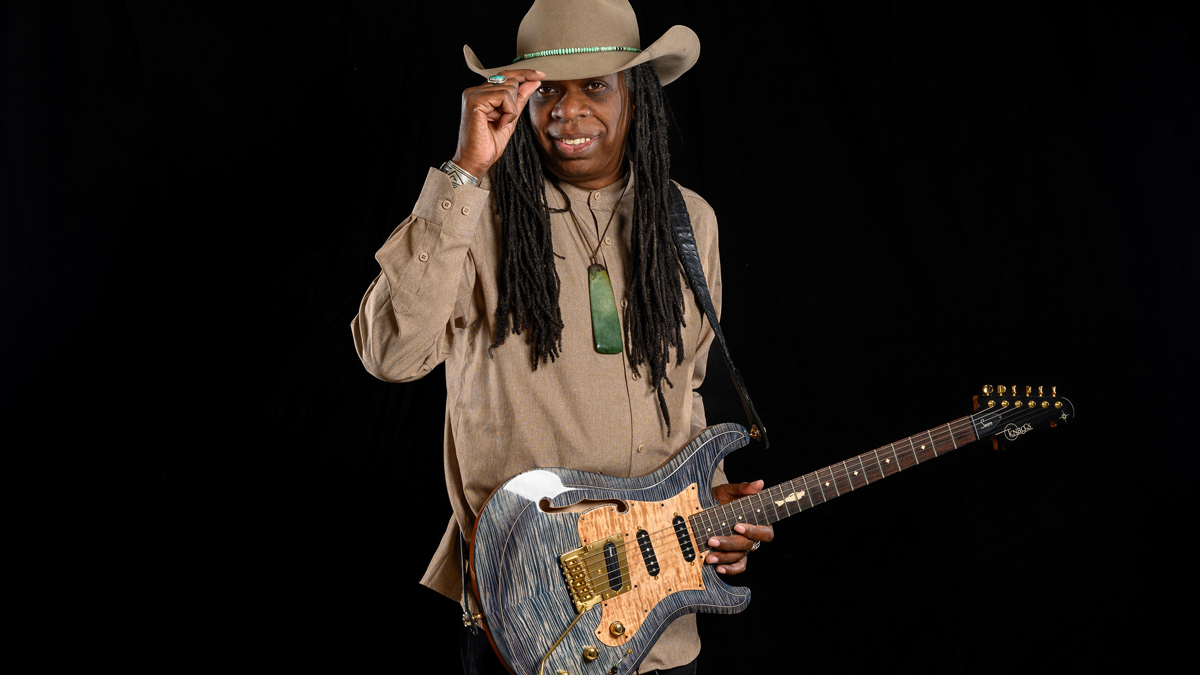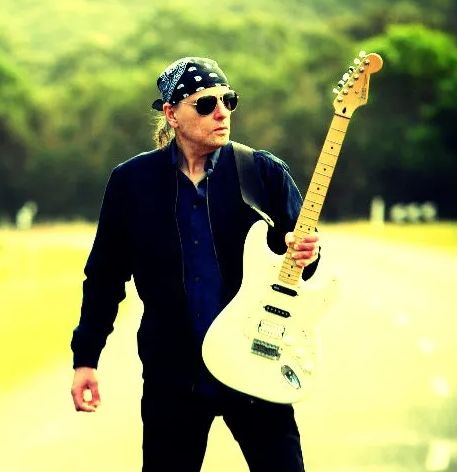“I did a round on the solo, and Ric Ocasek goes, ‘That’s really nice.’ He begins humming, and in my mind, I’m going, ‘But I didn't play that!’ He’d edited what I just played in his head”: Session great Larry Mitchell reflects on his all-star resume
He recorded with Ric Ocasek and Nile Rodgers, toured with Tracy Chapman, and every time he jams with Steve Vai the playing reaches “another level of epic-ness” – Larry Mitchell looks back on his star-studded session career

As an in-demand guitarist, Larry Mitchell has toured the world playing guitar for artists such as Tracy Chapman, Ric Ocasek and Billy Squier amongst many others.
Mitchell, who is also a Grammy award-winning producer, has also released several solo albums since he first came on to the scene in the late 1980s.
Guitar World caught up Mitchell while on tour in Australia and sat down to his discuss his textured approach to playing guitar, recording with late Cars frontman Ric Ocasek, his Knaggs signature guitar and much more.
One of the most important sessions of your career was playing guitar on Ric Ocasek’s 1991 album Fireball Zone. What do you remember about those sessions?
“Yes, Nile Rodgers was producing Fireball Zone. Nile asked me to come in and do a solo on one song: Rockaway. Which led to me playing on the rest of the record. I was a little nervous about that gig, but Nile had my rig brought in, which had the old [Rocktron] Bradshaw system in it and which featured Hartke speakers, a Mesa/Boogie Quad Preamp, a TC 2290 Delay, and an Eventide H3000, all my tones and stuff like that.
“On Rockaway, I did a first round on the solo which was kind of flashy and stuff like that, something that I normally did. And then I did another two more and I think it was the third take they kept. And of course, back then we were doing everything to tape, so you only got to do so many takes before they got what they wanted. But they wanted to keep everything.
“And then Ric goes, ‘That's really nice what you did there.’ He begins humming something, and in my mind, I'm going, ‘But I didn't play that.’ And then he hums it again and I'm thinking, ‘He has edited it in his head what I just played.’ That’s what Ric did, not Nile. Which has always made me think that though Elliot Easton's a great guitar player and very melodic, I wondered how much of that was Ric’s to start with?
Get The Pick Newsletter
All the latest guitar news, interviews, lessons, reviews, deals and more, direct to your inbox!
“So, Ric edited what I played, took out the notes that really didn't need to be there, and hummed some stuff to me, and I started to solo again that way, and it was great. And because of that, I ended up playing on eight songs as they had already done two songs with another guitarist, Dann Huff, before I had come in.”
You went on to become touring guitarist with Tracy Chapman. What approach did you use to recreate her recorded work in a live setting?
“There wasn't a ton of electric guitar on her records, so I just learned the parts that were supposed to be on the record. And then there were songs where I had to literally just make up parts, but I had to make sure I wasn’t too invasive as she had a lot of songs that were iconic songs that people knew very well. I couldn't take it too far out there.
Every time I jammed with Steve, it would be another level of epic-ness. It was always wonderful
“I remember doing only a few solos here and there. Oddly enough we ended each night with Give Me One Reason, which at that time hadn’t come out yet. So, every night we'd play that song, and I was like, trying to work out all this stuff. So, it was totally a different approach to the rest of her record.”
You also played with Steve Vai – what was that experience like?
“Yeah, I've been a fan of Steve since the early '80s. Whenever he was in New York I would go see him play. He was one of the influences, by accident, of me eventually becoming an Ibanez artist for 26 years.
“I had a great time with Steve. Every time I jammed with Steve, it would be another level of epic-ness. It was always wonderful. And a lot of times he would tell me to learn a song so that we could jam on it. So, I would do that, but then when I got on stage, Steve would go, ‘OK, Larry you start something.’ So, I would do something off the cuff and funky because that's my natural instinct, and we'd have a blast jamming over it.”
As a guitar player, how has your sound evolved over the years?
“I used to not be a fan of playing through Marshalls. I always had a clean amp that I would push with overdrive and distortion pedals – I had this old, Marshall 200-watt PA head that I wish I still had. But I just could not get along with it back then. I would use two or three pedals to get the sound. Now, I have a 1973 100-watt Marshall Plexi.
“I used to have a pedalboard, where I had two or three overdrives, along with a [Electro-Harmonix] Memory Man, and a DD-3 and the DD-5 Boss digital delay pedals, an original Boss [CE-1] Chorus Ensemble, the original heavy one, which I still have. Someone modded it, put a power supply in it, so that it would power on the rest of the pedals.
In the ‘80s, I did lots of sessions for different people, and everybody wanted me to play a lot, to be flashy and stuff like that
“I was living in New Mexico touring with a couple of Native American artists and I ended up having a suitcase that had two pedalboards in it. One with overdrives, a Boss OC-2 and a wah pedal and another pedalboard with a lot of my delays and modulations, tremolos and phasers, as I love textures! I used to carry around a huge rig. I've been a Fractal Audio artist since 2007, and because of that, it has actually helped me define my sound and simplify my setup.”
When you’re wearing your producer’s hat and working with an artist, and being a guitar player yourself, how do you approach the session objectively without influencing any musical decision from purely a guitarist standpoint?
“As a guitarist, I will usually do a couple of passes first, and usually I will play too much, but then I'll listen, and the producer in me takes over. And it's usually about playing less, and making sure I am being true to the artist.
“In the ‘80s, I did lots of sessions for different people, and everybody wanted me to play a lot, to be flashy and stuff like that. And so, you just did a couple of passes and they would go, ‘Yeah, that's right.’”
Is it hard to get out of that ‘flashy’ mindset?
“No, as I always aim to be a little bit more melodic. The first thing I do is probably top a bit of the melody, the vocal melody, especially if it's over the chorus section, so a little bit of that will get into the solo.”
Steve Stevens was integral to you finally hooking up with Knaggs guitars, as I understand it.
“Yes, he did turn me onto Knaggs guitars. When I was growing up, he was my local guitar hero and way before Billy Idol came along. Steve was great at putting insane guitar stuff in, something that I’m kind of like, too.”
You now play a signature model Knaggs guitar.
“My guitar is a Knaggs Signature Severn. The model is based on a ‘63 Fender Strat. It’s got a set neck, and has an 8.5” radius fretboard. The neck is a bit thicker than the Ibanez guitars I used to play but it feels great in my hands.
“It has a plate where the back pickup is, which helps transfer the sustain to the body. The tremolo arm has a rod that goes through it and it wraps around to this plate that’s screwed into the wood and it makes a huge difference to the sustain. The guitar is fitted with two DiMarzio Area 67 single coil pickups in neck and middle positions, and a DiMarzio Satch Track HB neck pickup in the bridge position.”
GW: Finally, what’s your current gear setup?
“The Knaggs Severn LM Semi hollow electric guitar, a Godin Multiac Mundial Nylon String guitar, Fractal Audio Systems FM3, an Eventide H90, a Boss RC-500, NUX C-5RC 5.8 GHz wireless – and a NUX Mighty Air Amp for warming up in the green room.”
Joe Matera is an Australian guitarist and music journalist who has spent the past two decades interviewing a who's who of the rock and metal world and written for Guitar World, Total Guitar, Rolling Stone, Goldmine, Sound On Sound, Classic Rock, Metal Hammer and many others. He is also a recording and performing musician and solo artist who has toured Europe on a regular basis and released several well-received albums including instrumental guitar rock outings through various European labels. Roxy Music's Phil Manzanera has called him, "... a great guitarist who knows what an electric guitar should sound like and plays a fluid pleasing style of rock." He's the author of Backstage Pass: The Grit and the Glamour.
“There’d been three-minute solos, which were just ridiculous – and knackering to play live!” Stoner-doom merchants Sergeant Thunderhoof may have toned down the self-indulgence, but their 10-minute epics still get medieval on your eardrums
“There’s a slight latency in there. You can’t be super-accurate”: Yngwie Malmsteen names the guitar picks that don’t work for shred



![A black-and-white action shot of Sergeant Thunderhoof perform live: [from left] Mark Sayer, Dan Flitcroft, Jim Camp and Josh Gallop](https://cdn.mos.cms.futurecdn.net/am3UhJbsxAE239XRRZ8zC8.jpg)









